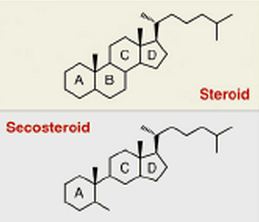If you have done even a modest amount of reading about health issues you know that there are many references to our need for additional vitamin D – especially the D3 version. Health food store shelves are making room for additional vitamin D supplements and our doctors are telling us to increase our intake – over and above the official Recommended Daily Allowance – the minimum amount needed to prevent illness.
Usually, our vitamin D needs are met because we make it in our bodies by the interaction of cholesterol and sunshine. This usually works fine unless we’re avoiding sunshine and trying to lower our cholesterol levels with drugs. Sunshine has long been recommended as a treatment for Seasonal Affective Disorder (SAD). Some doctors suggest their patients visit tanning parlors regularly during the cloudy winter months.
Why does a simple vitamin do so much for our general wellbeing? Probably because it isn’t just a simple substance.
I am reminded of the similarities between the chemical structure of steroids and that of vitamin D. Typically, steroids contain four rings (A, B, C, and D) and there are a variety of difference groups attached at various places on those rings. The differences in groups and places of attachment are what determine which steroid we’re looking at.
Vitamin D has a similar structure, but one of the rings (B) is opened. One thought led to another and I realized anew why vitamin D is vital for health, especially when it comes to keeping our bodies free of inflammation. It’s because its structure is so similar to the steroids. In fact, vitamin D has often been referred to as a secosteroid.
With all that is known about the benefits and actions of vitamin D, it is almost shocking to see how little attention it is afforded. That’s changing, but certainly not quickly enough.
Vitamin D safely reduces inflammation, which is being recognized as one of the underlying causes for many chronic health conditions. Multiple sclerosis, irritable bowel disease, psoriasis, diabetes, coronary artery disease, arthritis, and many others are linked to widespread systemic (affecting the body as a whole) inflammation. Clearly, additional vitamin D can offer relief to people who suffer from one or more of those chronic maladies. And a recent study from Denmark reports that even depression is linked to inflammation. People often report improvements when their vitamin D levels increase – whether by additional sunshine exposure or taking additional vitamin D3 supplements.
The above has led me to think about how vitamin D might be used to relieve sore muscles and joints, which is usually caused by inflammation.
Could topical vitamin D help?
We made up a small batch of vitamin D in a special cream base and tried it ourselves. Son-of-a-gun, it worked. Quickly. A small amount rubbed into a sore area brings relief – no burning, no smell, no skin irritation. The relief seems to last several hours. We made more and shared samples with friends and customers – usually with success.
It is available commercially, but we find the strengths to be too low. We found that relief comes when the amount is around 20,000 IU – applied once or twice daily.
Would you be interested in trying something like this? Let me know.
